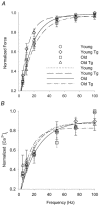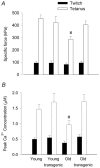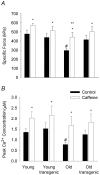Insulin-like growth factor-1 prevents age-related decrease in specific force and intracellular Ca2+ in single intact muscle fibres from transgenic mice
- PMID: 12937290
- PMCID: PMC2343464
- DOI: 10.1113/jphysiol.2003.048165
Insulin-like growth factor-1 prevents age-related decrease in specific force and intracellular Ca2+ in single intact muscle fibres from transgenic mice
Abstract
In the present work we test the hypothesis that sustained transgenic overexpression of insulin-like growth factor-1 (IGF-1) in skeletal muscle prevents age-related decreases in myoplasmic Ca2+ concentration and consequently in specific force in single intact fibres from the flexor digitorum brevis (FDB) muscle from the mouse. Measurements of IGF-1 concentration in FDB muscle showed higher levels in transgenic than in wild-type mice at all ages. The specific tetanic force decreased significantly in single muscle fibres from old (286 +/- 22 kPa) compared to young wild-type (455 +/- 28 kPa), young transgenic (423 +/- 43 kPa), and old transgenic mice (386 +/- 15 kPa) (P < 0.05). These results are consistent with measurements in whole FDB muscles. The peak Ca2+ concentration values in response to prolonged stimulation were: 1.47 +/- 0.15, 1.70 +/- 0.29, 0.97 +/- 0.13 and 1.7 +/- 0.22 microM, in fibres from young wild-type, young transgenic, old wild-type and old transgenic mice, respectively. The effects of caffeine on FDB fibres support the conclusion that the age-related decline in peak myoplasmic Ca2+ and specific force is not explained by sarcoplasmic reticulum Ca2+ depletion. Immunohistochemistry in muscle cross-sections was performed to determine whether age and/or IGF-1 overexpression induce changes in fibre type composition. The relative percentages of type IIa, IIx and I myosin heavy chain (MHC) isoforms did not change significantly with age or genotype. Therefore, IGF-1 prevents age-related decline in peak intracellular Ca2+ and specific force in a muscle that does not exhibit changes in fibre type composition with senescence.
Figures






Similar articles
-
Mechanical properties of intact single fibres from wild-type and MLC/mIgf-1 transgenic mouse muscle.J Muscle Res Cell Motil. 2009;30(5-6):199-207. doi: 10.1007/s10974-009-9187-8. J Muscle Res Cell Motil. 2009. PMID: 19731048
-
Sustained overexpression of IGF-1 prevents age-dependent decrease in charge movement and intracellular Ca(2+) in mouse skeletal muscle.Biophys J. 2002 Mar;82(3):1338-44. doi: 10.1016/S0006-3495(02)75489-1. Biophys J. 2002. PMID: 11867450 Free PMC article.
-
Mitochondrial and myoplasmic [Ca2+] in single fibres from mouse limb muscles during repeated tetanic contractions.J Physiol. 2003 Aug 15;551(Pt 1):179-90. doi: 10.1113/jphysiol.2003.043927. Epub 2003 Jun 18. J Physiol. 2003. PMID: 12815178 Free PMC article.
-
Mechanisms underlying changes of tetanic [Ca2+]i and force in skeletal muscle.Acta Physiol Scand. 1996 Mar;156(3):407-16. doi: 10.1046/j.1365-201X.1996.196000.x. Acta Physiol Scand. 1996. PMID: 8729701 Review.
-
Insulin-like growth factor isoforms in skeletal muscle aging, regeneration, and disease.Cold Spring Harb Symp Quant Biol. 2002;67:507-18. doi: 10.1101/sqb.2002.67.507. Cold Spring Harb Symp Quant Biol. 2002. PMID: 12858577 Review. No abstract available.
Cited by
-
Sphingomyelinase promotes oxidant production and skeletal muscle contractile dysfunction through activation of NADPH oxidase.Front Physiol. 2015 Jan 21;5:530. doi: 10.3389/fphys.2014.00530. eCollection 2014. Front Physiol. 2015. PMID: 25653619 Free PMC article.
-
Paracrine effects of IGF-1 overexpression on the functional decline due to skeletal muscle disuse: molecular and functional evaluation in hindlimb unloaded MLC/mIgf-1 transgenic mice.PLoS One. 2013 Jun 3;8(6):e65167. doi: 10.1371/journal.pone.0065167. Print 2014. PLoS One. 2013. PMID: 23755187 Free PMC article.
-
Myosin binding protein-C slow: an intricate subfamily of proteins.J Biomed Biotechnol. 2010;2010:652065. doi: 10.1155/2010/652065. Epub 2010 Apr 8. J Biomed Biotechnol. 2010. PMID: 20396395 Free PMC article. Review.
-
Massive alterations of sarcoplasmic reticulum free calcium in skeletal muscle fibers lacking calsequestrin revealed by a genetically encoded probe.Proc Natl Acad Sci U S A. 2010 Dec 21;107(51):22326-31. doi: 10.1073/pnas.1009168108. Epub 2010 Dec 6. Proc Natl Acad Sci U S A. 2010. PMID: 21135222 Free PMC article.
-
The effects of testosterone and insulin-like growth factor 1 on motor system form and function.Exp Gerontol. 2015 Apr;64:81-6. doi: 10.1016/j.exger.2015.02.005. Epub 2015 Feb 11. Exp Gerontol. 2015. PMID: 25681641 Free PMC article. Review.
References
-
- Allen DG, Duty S, Westerblad H. Metabolic changes in muscle during exercise; their effects on muscle function. Proc Aust Physiol Pharmacol Soc. 1993;24:65–75.
-
- Ashley CC, Mulligan IP, Lea TJ. Ca2+ and activation mechanisms in skeletal muscle. Q Rev Biophys. 1991;24:1–73. - PubMed
-
- Bakker AJ, Head SI, Stephenson DG. Time course of calcium transients derived from Fura-2 fluorescence measurements in single fast twitch fibres of adult mice and rat myotubes developing in primary culture. Cell Calcium. 1997;21:359–364. - PubMed
Publication types
MeSH terms
Substances
Grants and funding
LinkOut - more resources
Full Text Sources
Other Literature Sources
Medical
Molecular Biology Databases
Research Materials
Miscellaneous

